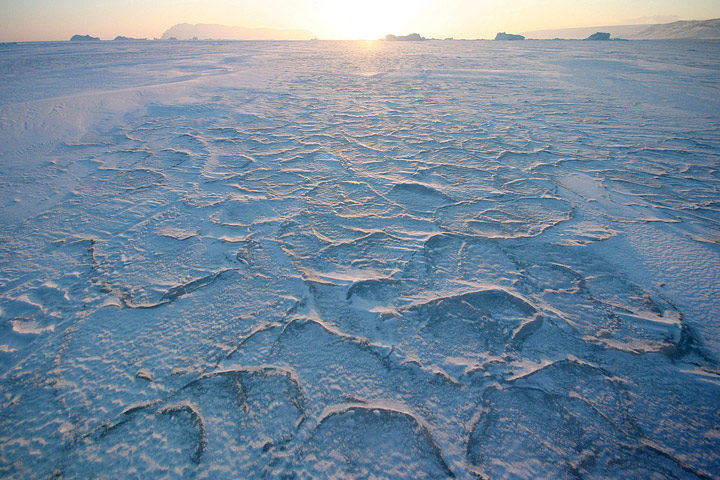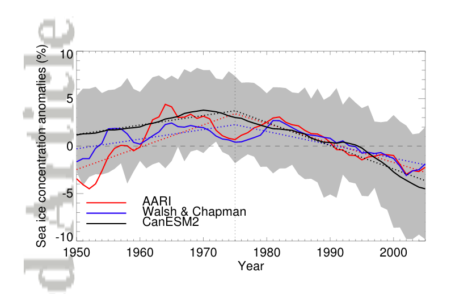Most NASA stories about sea ice records tend to start with the year 1979, when consistent observations started to be collected regularly by satellites. But we do know a bit about what happened before then based on aerial, ocean, and ground-based data. And now some recently recovered observations and new modeling suggest that Arctic sea ice grew for a period between 1950 and 1975.

The Sun hangs low on the horizon above solidified pancake ice in the Arctic Ocean. (Photograph courtesy Andy Mahoney, NSIDC.)
A new analysis led by Marie-Ève Gagné of Environment and Climate Change Canada offers an explanation for the rise: air pollution. Gagné and colleagues showed that sulfate aerosol particles, which are released by the burning of fossil fuels, may have disguised the impact of greenhouse gases on Arctic sea ice.
In a press release, the American Geophysical Union explained more details:
These particles, called sulfate aerosols, reflect sunlight back into space and cool the surface. This cooling effect may have disguised the influence of global warming on Arctic sea ice and may have resulted in sea ice growth recorded by Russian aerial surveys in the region from 1950 through 1975, according to the new research.
“The cooling impact from increasing aerosols more than masked the warming impact from increasing greenhouse gases,” said John Fyfe, a senior scientist at Environment and Climate Change Canada and a co-author of the new study accepted for publication in Geophysical Research Letters.
To test the aerosol idea, researchers used computer modeling to simulate sulfate aerosols in the Arctic from 1950 through 1975. Concentrations of sulfate aerosols were especially high during these years before regulations like the Clean Air Act limited sulfur dioxide emissions that produce sulfate aerosols.
The study’s authors then matched the sulfate aerosol simulations to Russian observational data that suggested a substantial amount of sea ice growth during those years in the eastern Arctic. The resulting simulations show the cooling contribution of aerosols offset the ongoing warming effect of increasing greenhouse gases over the mid-twentieth century in that part of the Arctic. This would explain the expansion of the Arctic sea ice cover in those years, according to the new study.
Aerosols spend only days or weeks in the atmosphere so their effects are short-lived. The weak aerosol cooling effect diminished after 1980, following the enactment of clean air regulations. In the absence of this cooling effect, the warming effect of long-lived greenhouse gases like carbon dioxide has prevailed, leading to Arctic sea ice loss, according to the study’s authors.
Read more about aerosols and sea ice.

This chart, from Gagné et al, shows the area-averaged annual mean sea ice concentration anomaly between 1950 and 2005. The red line reflects Arctic and Antarctic Research Institute (AARI) data, which is based on historical sea ice charts from several sources (aircraft, ship, and satellite observations). The blue Walsh & Chapman data includes additional historical sources and uses slightly different techniques for merging various data streams. The black line is a simulated mean sea ice concentration from the CanESM2 large ensemble, a group of models developed at the Canadian Center for Climate Modelling and Analysis. Anomalies are relative to climatological averages between 1975 and 2005. The time series have been lightly smoothed with 5-year running mean. The gray shading shows the 5-95 percent range over the individual simulations of the model ensemble. The dotted lines are the piecewise linear approximated trends.




Does this mean that we need aerosols to keep the planet from warming?
Why not?
Breathing aerosols makes you sick. Certain kinds, including sulfates, wash out in in rain,making the rain water acid, which caused a lot vegetation die off in the 1970s (along with animals that depended on certain plants, and fish, that died in the acid riverwater). Depending on where the aerosols are, they can change rainfall patterns and affect food crops. So generally, it is a bad idea to pollute the place we all live.